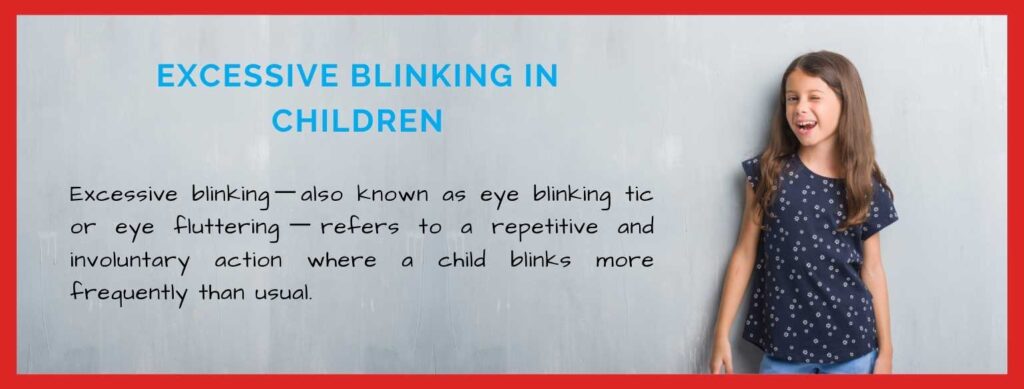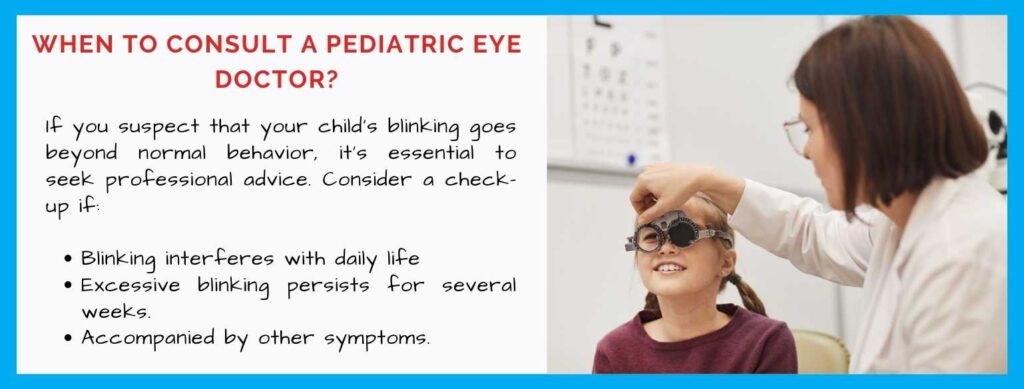Excessive blinking in children can concern parents, and understanding its causes, symptoms, and potential solutions is crucial.
In this blog post, we’ll explore this common issue providing insights and guidance for parents seeking to help their children overcome excessive blinking.
What is excessive blinking in children?
Excessive blinking refers to a repetitive action where a child blinks more frequently than usual.
While blinking is a natural reflex that helps protect and lubricate the eyes, excessive blinking goes beyond the normal range, becoming a noticeable and persistent behavior. Some examples include:
- Frequent, rapid blinking in a rhythmic pattern
- Blinking that persists for extended periods
- Intensified blinking in response to stress or anxiety
- A tendency for blinking to worsen over time
- Possible accompanying facial or body tics
What are the causes of excessive blinking in children?
Several factors contribute to excessive blinking in children. Exploring and understanding these causes is essential to providing appropriate support and intervention.
WHY DO WE BLINK?
Blinking is a normal reflex that protects the eye from dryness, bright lights, foreign objects, fingers, or other debris coming towards it. Blinking also regulates tears which nourish and cleanse the surface of the eye. The blinking rate in newborns is only 2 times per minute. This increases to 14-17 times per minute in adolescence and remains at this rate through the remainder of life. Blinking can also increase in response to pain, bright light, changes in temperature and humidity, and conversation.
WHAT CAUSES EXCESSIVE BLINKING?
Excessive blinking can be caused by problems with the eyelids or anterior segment (front surface of the eye), habitual tics, refractive error (need for glasses), intermittent exotropia or turning out of the eye, the environment (changes in temperature or humidity, bright lights, or pain), and stress. It is very rare for excessive blinking to be a sign of an undiagnosed neurologic disorder.
HOW CAN EXCESSIVE BLINKING BE EVALUATED AND DIAGNOSED?
A pediatric ophthalmologist will be able to diagnose the cause of the symptoms. A thorough exam will be performed. If there is a problem such as an ingrown eyelash, corneal abrasion (scratch on the front surface of the eye), conjunctivitis (pink eye), foreign body in the eye, or allergies affecting the eye or eye dryness, this can easily be diagnosed by performing an examination with an instrument called a slit lamp. This is a special microscope used to magnify the eye. If glasses are needed, this can also be easily detected though many times requiring a dilated eye exam. Any strabismus (in turning or out turning of the eye) will be diagnosed when the ophthalmologist examines the eye movements.
HOW IS EXCESSIVE BLINKING TREATED?
If an abrasion or conjunctivitis is diagnosed, eye drops or ointment may be given. Glasses may be prescribed if the excessive blinking is caused by blurry vision. The treatment will depend on the reason for the excessive blinking. If the complete eye exam is normal, the family may be reassured and recommended to monitor the symptoms.
WHAT IS A HABITUAL TIC?
A habitual tic is a small, semi-voluntary body movement. It may be caused by stress, fatigue, or boredom among many other causes. It usually affects both eyes at the same time. It affects boys twice as often as girls with the average age of starting symptoms around 5 years. It is a benign condition that will resolve without treatment usually within weeks to years though often recurring intermittently. There is no neurologic cause and further evaluation with brain scans are not necessary. If the child displays multiple tics and/or auditory (vocal) tics than an appointment with a neurologist is indicated. Once an ophthalmologist has determined that a child does not have an eye problem, it is best for parents not to draw attention or discuss the excessive blinking as the symptoms tend to diminish on their own. Habitual tics that persist should be discussed with the child’s pediatrician who may be helpful in identifying ways to manage stress, anxiety, or other possible triggers.
1. Environmental triggers
Environmental factors can play a role in exacerbating excessive blinking. Stress, anxiety, and changes in routine or surroundings may trigger or intensify the blinking behavior in susceptible children.
2. Allergies and eye irritations
Children with allergies or other eye irritations may respond with excessive blinking as their eyes attempt to alleviate discomfort. Allergens like pollen, dust, or pet dander can irritate the eyes, leading to increased blinking.
3. Vision problems and refractive errors
Uncorrected vision problems can strain the eyes, such as nearsightedness or farsightedness. This can cause children to blink excessively in an attempt to compensate for their visual challenges.
4. Neurological factors
Excessive blinking can be a common symptom in tic disorders, a neurological condition characterized by repetitive and involuntary movements or vocalizations. Tic disorders can be classified into two main types: Tourette’s syndrome and chronic motor or vocal tic disorder.
Children with Tourette’s syndrome may blink rapidly and repeatedly, sometimes accompanied by other facial or body tics.
5. Dry eye syndrome
Insufficient tear production or poor tear quality can result in dry eyes, leading to increased blinking as a reflex to lubricate the eyes.
6. Eyelid problems
Issues with the eyelids, such as inflammation (blepharitis) or spasms (blepharospasm), can cause excessive blinking in children.
7. Habitual behavior
Sometimes, excessive blinking may start as a simple habit or mimicry of others and become ingrained over time.
8. Medications
Certain medications can have side effects that cause eye irritations or nervous system responses, leading to excessive blinking.
How can you differentiate normal blinking from excessive blinking?
Distinguishing between normal and excessive blinking is essential for parents to identify potential issues in their children’s eye health. Here are some important patterns to observe:
Observe blinking patterns
Take note of your child’s blinking patterns over a few days. Normal blinking should be occasional and effortless, whereas excessive blinking will be noticeably frequent and repetitive.
Pay attention to triggers
Stress, anxiety, or specific situations might trigger or exacerbate excessive blinking. If you notice a correlation between blinking and specific events, it may be a sign of a problem.
Consider environmental factors
Evaluate any changes in your child’s environment that might contribute to the blinking. New allergens or irritants in the surroundings could be causing eye discomfort.
Rule out vision problems
If your child frequently complains of headaches, eye strain, or blurry vision, it could indicate underlying vision issues, leading to excessive blinking.
When should parents consult a pediatric eye doctor?
If you suspect that your child’s blinking goes beyond normal behavior, it’s essential to seek professional advice. Consider going to your trusted pediatric eye doctor if:
-
Blinking interferes with daily life
If excessive blinking impacts your child’s daily activities, school performance, or social interactions, it’s time to consult an eye specialist.
-
Blinking persists for several weeks
Occasional blinking episodes are usually harmless, but a professional evaluation is warranted if the behavior persists for over a few weeks without improvement.
-
Accompanying symptoms or tics
A medical evaluation is crucial if the excessive blinking is accompanied by other concerning symptoms or tics, such as head jerking or facial grimacing.
A pediatric eye examination is crucial in determining the cause of excessive blinking and ensuring your child’s eye health.
During an eye exam, the physician will take a comprehensive medical history of the patient and perform the following: visual acuity assessment, external eye exam, and pupil and eye movement evaluation.
After the examination, the eye specialist will diagnose your child based on their findings. They will then suggest appropriate treatments, including a combination of therapy and lifestyle adjustments.
What are the available solutions and treatment options?
The solutions and treatment options for excessive blinking in children depend on the underlying cause and severity of the condition. It’s essential to consult a pediatric optometrist or opthalmologist to determine the most suitable approach.
Here are some potential solutions and treatment options:
1. Vision therapy
Vision therapy is a specialized program conducted by optometrists to improve visual function and efficiency.
It involves a series of exercises and activities designed to strengthen eye muscles, enhance eye coordination, and improve visual processing.
2. Medications
In certain cases, your doctor may prescribe medications to manage excessive blinking, particularly related to tic disorders like Tourette’s syndrome. Medications can help reduce the frequency and intensity of tics, including blinking.
3. Behavioral interventions
Behavioral therapy, such as habit-reversal training, can benefit children with tic-related excessive blinking.
It involves teaching the child to recognize the urge to blink excessively and redirecting the behavior to more socially acceptable actions.
4. Eye lubrication
If excessive blinking is caused by dry eyes, using artificial tears or lubricating eye drops can help keep the eyes moist and reduce the urge to blink excessively.
5. Stress management
Since stress and anxiety can exacerbate excessive blinking, helping children manage stress through relaxation techniques, mindfulness, or counseling can be beneficial.
6. Supportive environment
Creating a supportive and understanding environment for the child can reduce anxiety and stress, which may, in turn, help manage excessive blinking.
7. Surgical interventions
Surgical options may be considered in rare cases where other treatments are ineffective, and the blinking severely impacts the child’s quality of life.
Surgical procedures aim to alleviate pressure on the eye muscles or nerves responsible for blinking.
8. Education and awareness
Educating teachers, peers, and caregivers about the child’s condition can foster empathy and reduce misunderstandings, making it easier for the child to cope with excessive blinking.
Remember, each child is unique, and what works for one may not be the best option for another. Collaborating with healthcare professionals and considering the child’s specific needs and preferences is essential in determining the most effective solutions and treatments for excessive blinking.
Discover a brighter future for your child’s eyes at Pediatric Eye Associates
At Pediatric Eye Associates, we pride ourselves on being the premier facility dedicated to children’s eye health. With a team of highly skilled pediatric eye specialists, state-of-the-art technology, and a warm, child-friendly environment, we ensure your child receives the best care possible.
Give your child the gift of a clear and healthy vision. Contact us today to schedule an appointment with our dedicated team of pediatric eye doctors.
The material contained on this site is for informational purposes only and DOES NOT CONSTITUTE THE PROVIDING OF MEDICAL ADVICE, and is not intended to be a substitute for independent professional medical judgment, advice, diagnosis, or treatment. Always seek the advice of your physician or other qualified healthcare providers with any questions or concerns you may have regarding your health.



